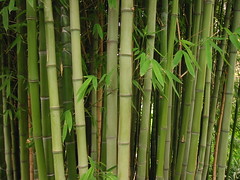 Image by mike lowe via FlickrBy Ivy Newport
Image by mike lowe via FlickrBy Ivy NewportMore and more we hear about bamboo as an eco-friendly option to the pesticide laden cotton crops. Yet, while the hype about bamboo may make it appear to be a perfect solution to the environmental manufacturing dilemma, unfortunately, the manufacturing process has managed to compromise even this super plant.
Here are some of the amazing properties of bamboo.
- Fastest growing plant on the planet: some species grow up to 4 feet per day. It takes between 3-5 years to be ready to harvest compared to 30-50 years for its hardwood counterparts.
- Does not require replanting because of its extensive root system which sends up new shoots, naturally replenishing itself.
- Produces 30% more oxygen than a forest of comparable size and removes carbon dioxide from the atmosphere
- Its growth actually prevent soil erosion
- It can grow without pesticides or chemicals
- It requires no water irrigation to grow
- Perfect for fabric manufacturing as it is three times more absorbent than cotton, extremely soft, hard to wrinkle, and possesses natural antibacterial properties.
Mechanical Processing
The woody parts of the bamboo plant are crushed and then natural enzymes are used to break the bamboo walls into a mushy mass so that the natural fibres can be mechanically combed out and spun into a yarn usually called bamboo linen. This process is more labour intensive and expensive than chemical processing.
Chemical Processing
Referred to as Bamboo Rayon, chemically manufactured bamboo fibre is a regenerated cellulose fibre. This process requires cooking the bamboo leaves and woody shoots in strong chemical solvents such as sodium hydroxide and carbon disulfide, followed by multi-phase bleaching.
Both of these chemicals have been linked to serious health problems for workers such as tiredness, headache, and possible nerve damage. These chemicals are also dangerous for the environment as they can escape into the atmosphere through air vents and smokestacks. Waterways can also be damaged through inadequately treated waste water disposal systems.
Looking for bamboo fabrics is not enough when trying to make a more informed and environmental choice. It is important to determine how the bamboo has been processed. While bamboo alone is an amazingly renewable, sustainable and abundant resource, it becomes important to avoid Bamboo Rayon and look for Bamboo Linens that are Oeko-Tek certified, which means the product is free of processing chemicals.
About the Author
Ivy Newport is the resident "green expert" at Every Little Bit Eco Shop, an online store offering everyday products that are conveniently green. Visit http://www.everylittlebitgreen.com for more tips & education on going green, as well as a wide variety of eco-friendly products for greener living and greener giving.
Article Source: http://EzineArticles.com/?expert=Ivy_Newport
http://EzineArticles.com/?The-Truth-About-Bamboo-in-Clothing---Eco-Friendly-or-Not?&id=6015850

Hi,
ReplyDeleteThanks for sharing this unique information about Bamboo trees..
Bamboos make me think of pandas <3 thanks for sharing this
ReplyDeletehttp://daphyin-makeupisart.blogspot.com